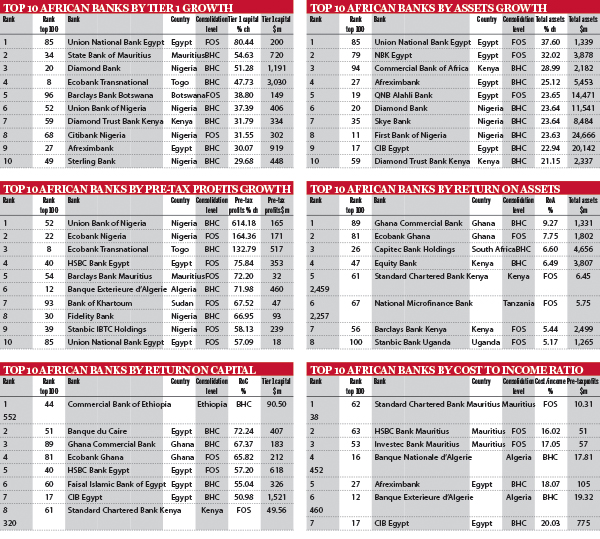The Banker, a Financial Times publication, has featured 16 Egyptian lenders in its 2016 ranking of Top 100 African Banks, it said in a report released in its website Monday.
According to the table shown below, the Commercial International Bank, biggest private bank in Egypt, ranked seventeenth on The Banker‘s Top 100 African Banks list. Banque Du Caire, the second biggest state-run Egyptian bank, was placed 51th; while Faisal Islamic Bank of Egypt came 60th.
The Gulf-based lenders, the Union National Bank of Egypt, NBK-Egypt, and QNB Alahli Bank ranked 85th, 79th, and 19th, respectively. Meanwhile, the African Export-Import Bank (Afreximbank), the International financial institution that headquartered in Cairo, was placed in 27th position in The Banker’s rating.
The ranking is the definitive measure of the health, performance and growth of leading African banks. The ranking tracks the 100 largest African banks in terms of Tier 1 Capital and total assets. The Banker’s ranking of the top African banks demonstrates why returns in the continent are the highest in the world. Nigeria is realising its potential with average return on capital nearing 25%, while South African banks dominate the top positions in terms of Tier 1 capital.
“Egyptian and Nigerian lenders put in the most notable performances in The Banker‘s Top 100 African Banks ranking, while South African institutions continue to dominate the upper echelons of the table.” It said
This year’s African banks ranking offers another snapshot of a continent on the rise. In aggregate terms, Africa’s top 100 lenders, measured by their year-end 2014 Tier 1 capital, recorded stellar gains according to most metrics. Total assets hit $1230 billion accompanied by year-on-year asset growth of 5.03%. Encouragingly, these assets are being put to good use. The aggregate return on assets for these banks was 2.2% while their year-on-year pre-tax profit growth was a healthy 10.32%. The total value of pre-tax profits for 2014 edged slightly over $27 billion. Meanwhile, the aggregate return on capital of the top 100 lenders hit a staggering 27.6%, up from the 25% recorded in the 2015 ranking.
Within this bigger picture some markets have excelled by surpassing regional average performance figures, while others have fared less favourably. In particular, the impact of lower commodity prices, coupled with more stringent regulations, among other factors, had started to weigh on some lenders by the end of 2014. Elsewhere, encouraging political and economic reforms are opening up new frontiers for the continent’s banking sector, allowing higher growth markets to show their longer term promise.
Egypt
In the 2016 ranking, Egyptian lenders emerged as the standout performers. The country’s improving political environment, coupled with a promising programme of economic reforms, has been a source of optimism for many lenders. With a population of more than 80 million and banking sector penetration of about 10%, as well as extensive and ongoing infrastructure investments, growth opportunities in the country are abundant.
The total assets of the 16 Egyptian lenders featured in the ranking grew by 16.7% year on year, reaching $204.8 billion. Their aggregate return on assets came in at 2.39% while year-on-year pre-tax profit growth hit 24.9%. Notably, the aggregate Tier 1 capital growth of Egypt’s banks hit 13.26% over the review period while their return on capital exceeded the regional average at 38.9%.
Four Egyptian lenders featured in the top 10 banks by asset growth, compared with none in the 2015 edition. Two foreign-owned subsidiaries with Gulf-based parent entities – Union National Bank Egypt and NBK Egypt – topped the table in this category, pointing to the impressive gains made by foreign lenders who have entered the market in recent years. Meanwhile, four Egyptian lenders also featured in the top 10 banks by return on capital, with Banque du Caire taking the number two spot with a return of 72.2%.

